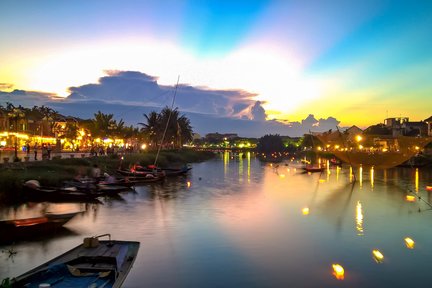Hoi An Ancient Town

The best of Hoi An Ancient Town
Bucket-list experiences
Make it a getaway
Trouble-free transport
More to explore
Why people love Hoi An Ancient Town
Nearby places to go
FAQs about Hoi An Ancient Town
When is the best time to visit Hoi An Ancient Town?
How can I get to Hoi An Ancient Town?
What is the best way to explore Hoi An Ancient Town?
Is there an entrance fee for Hoi An Ancient Town?
What should I keep in mind when visiting Hoi An Ancient Town?
How can I visit the Cham Islands from Hoi An?
What to know before visiting Hoi An Ancient Town
Remarkable Landmarks and Must-Visit Sights
Old Town Hội An
The historic district of Hội An, known for its well-preserved architecture and street plan reflecting a blend of indigenous and foreign influences. Wander through the ancient streets and admire the traditional wooden houses, temples, and assembly halls.
Japanese Bridge
A 16th-17th century covered bridge built by Japanese merchants, featuring a unique structure with a Buddhist temple attached on one side. It is one of the most iconic landmarks in Hội An.
Hoi An Lantern Full Moon Festival
Held on the 14th day of each lunar month, this festival illuminates the town with thousands of lanterns, creating a magical atmosphere. Visitors can enjoy traditional music, dance performances, and street food while participating in the ritual of releasing floating lanterns on the Thu Bon River.
Culture and History
Hội An's history dates back to the Cham period (2nd century-15th century) when it was a strategic spice trade center. The town later flourished as a trading port under Vietnamese rule, attracting merchants from Japan, China, and Europe. Its well-preserved architecture and cultural practices reflect a blend of these influences.
Local Cuisine
Hội An is renowned for its distinctive regional cuisine, including signature dishes like Cao lầu (braised spiced pork noodle), Mi quang (noodles), and Banh mi (Vietnamese sandwich). The town also offers cooking classes where visitors can learn to make these traditional dishes.
Culture and History
Hoi An has been a central port for historically important trade routes since the first century. Its multicultural history includes influences from Chinese, Dutch, Japanese, Indian, and Portuguese traders. The town's architecture and street plan reflect this rich heritage, making it a living museum of Vietnamese history.
Local Cuisine
Hoi An is renowned for its unique culinary offerings. Must-try dishes include Cao Lau, a noodle dish made with water from the ancient Ba Le Well, and White Rose Dumplings, a local delicacy. The town's vibrant food scene offers a variety of dining experiences, from street food stalls to upscale restaurants.
Culture and History
Hoi An's historical significance dates back to its role as a thriving trading port from the 15th to the 20th century. The town's architecture reflects the influence of Chinese, Japanese, and Portuguese traders. UNESCO recognized Hoi An as a World Cultural Heritage site in 1999, highlighting its well-preserved structures and urban lifestyle.
Local Cuisine
Hoi An offers a variety of local dishes that are a must-try for any visitor. Popular dishes include Banh Mi, Cao Lau, Quang noodles, Hoi An chicken rice, Bánh Xèo (Vietnamese Pancake), and Banh Dap (Smashed rice pancake). Each dish offers unique flavors that reflect the town's cultural melting pot.



